The Canadian Armoured Vehicle General Purpose Family
By Robert Kelly
In 1974 the Canadian Armed Forces issued a requirement for an Armoured Vehicle General Purpose (AVGP) to equip both Regular and Reserve units. Three prototypes made it to the final evaluation from a field of fourteen. The Brazilian URUTU and the U.S. Commando fell by the wayside and the Swiss MOWAG Piranha 6 X 6 won the evaluation.
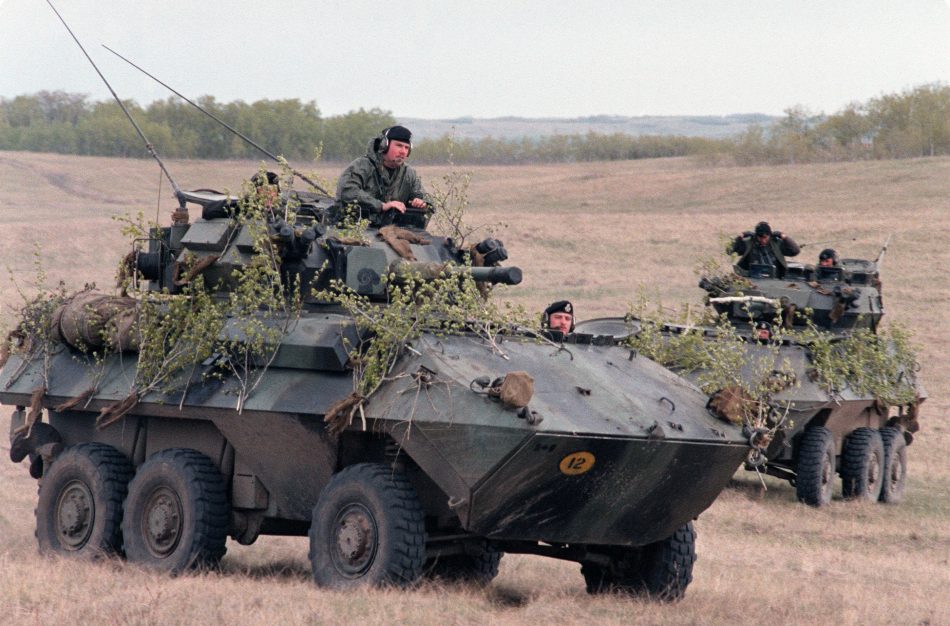 The 6×6 Mowag Piranha was chosen as the basis for a new family of CF wheeled armoured vehicles in 1976. A licensed production contract was undertaken by GM Canada’s Diesel Division of London, Ontario in August 1976, for the production of the AVGP family for the Canadian Forces with the first vehicles handed over in February 1978. Production was completed in 1982 by which time 491 had been built in three versions. Each of the variants is pictured below.
The 6×6 Mowag Piranha was chosen as the basis for a new family of CF wheeled armoured vehicles in 1976. A licensed production contract was undertaken by GM Canada’s Diesel Division of London, Ontario in August 1976, for the production of the AVGP family for the Canadian Forces with the first vehicles handed over in February 1978. Production was completed in 1982 by which time 491 had been built in three versions. Each of the variants is pictured below.
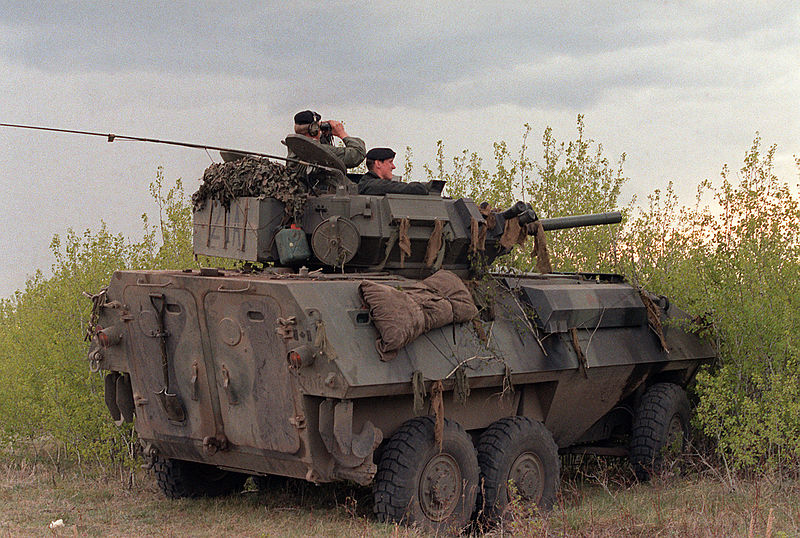
There were three different configurations that were built: the Grizzly ISC infantry section carrier or armoured personal carrier ( APC) mounting 2 machine guns in a small turret with 269 being built, the Cougar with a 76mm main gun with 195 being built, and Husky repair/recovery vehicles with 27 being built.

I will only be discussing the Cougar and Grizzly vehicles. The three AVGP variants differed from each other primarily by turret types or specialty equipment fitted. They shared the same basic hull arrangement with the same suspension & running gear. A diesel engine was mounted in the right front of the hull. The driver sat to the left of the engine and selected either four-rear-wheel drive for road travel or six-wheel drive for off-road. The crew commander sat directly behind the driver in the Cougar turret.
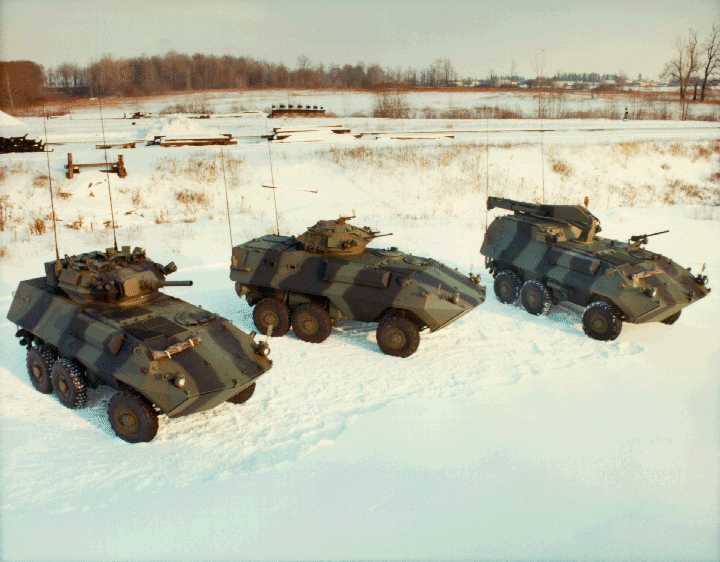
When introduced in 1978, the wheeled AVGPs were meant to provide the Regular force units with a training platform for tank operations and the Reserves with training vehicles that were less maintenance-intensive than tracked armour, they were never intended to be operational vehicles. However these characteristics made the AVGPs appealing for overseas deployments on Regular Force Peacekeeping & NATO missions – AVGPs were soon serving beyond their intended roles serving in Cyprus, Somalia, the Balkans, Rwanda, and elsewhere.
Modelling
This is a very quick and easy conversion to provide your army with a uniquely Canadian vehicle. The only drawback is that you have to buy two kits to make one vehicle. I actually got many of my turrets from a friend who 3D printed them.
You will need the USMC Lav 25 box set and the British Scimitar/Scorpion box set. Build the Scorpion version of the turret as per the instructions and set it aside. The easy part is now done.
Assemble the Lav 25 hull but do not put the wheels on. The Lav 25 is 420 mm longer than the Cougar. That equates to 4.2mm in 1/100 scale.
So, we have to cut out approximately 4 mm from the hull. I cut out 5mm. Make two cuts, one on either side of the louvered vent as per the photo. Save the louvered vent for later, but first sand the underneath of it right down to make it thin. Glue the hull halves together. Add the vent that you saved as per the photo. Add the gun traverse guard to the forward vent. Use styrene plastic for this. Cut out two trapezoid-shaped pieces of plastic to go between the first and second road wheels. It’s now starting to look like a Cougar and not a Lav 25 hull.
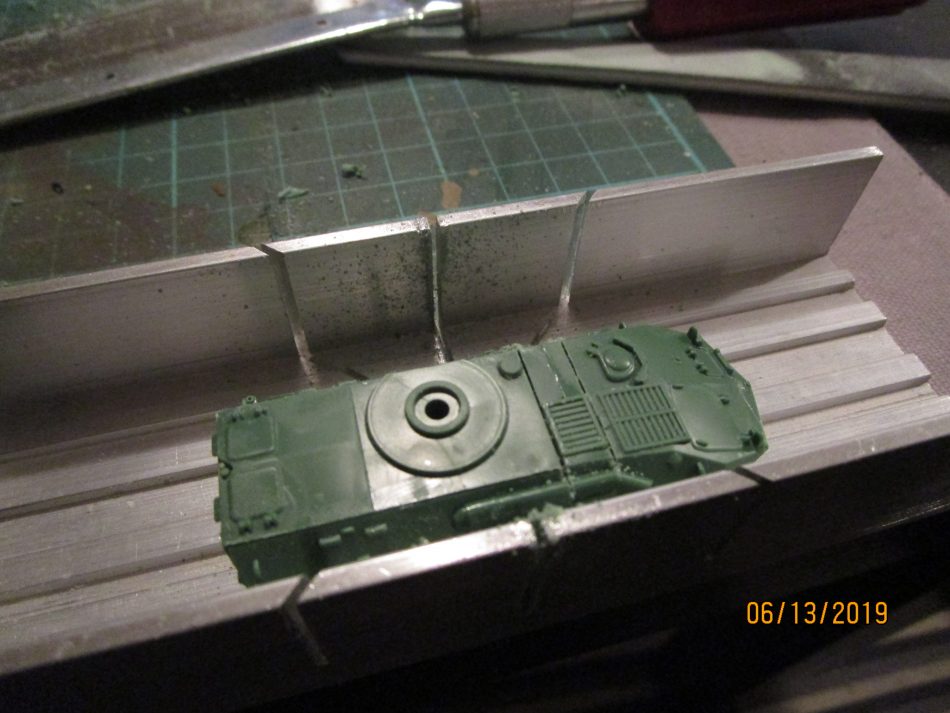
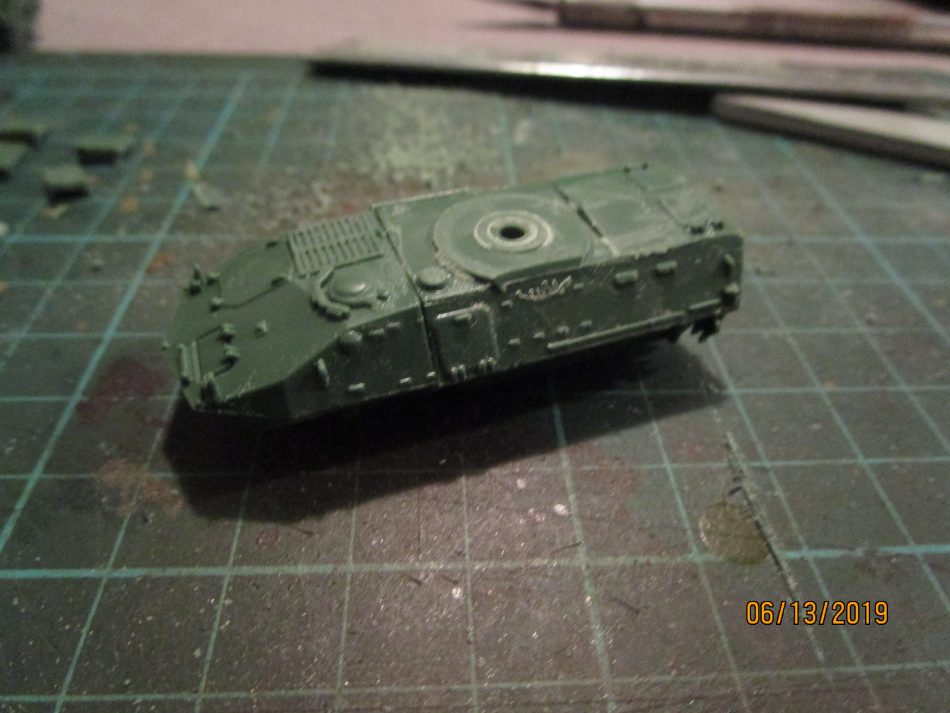


Sand down the hatch on the left side of the hull along with any other details if you wish. Drill a new hole for turret as per the photo below. Trim the turret ring so that it’s not so visible when the turret is mounted further back.
Note that the Grizzly is on the left. The difference being the extra hatch behind the driver. The hole for the turret will also be moved back slightly.
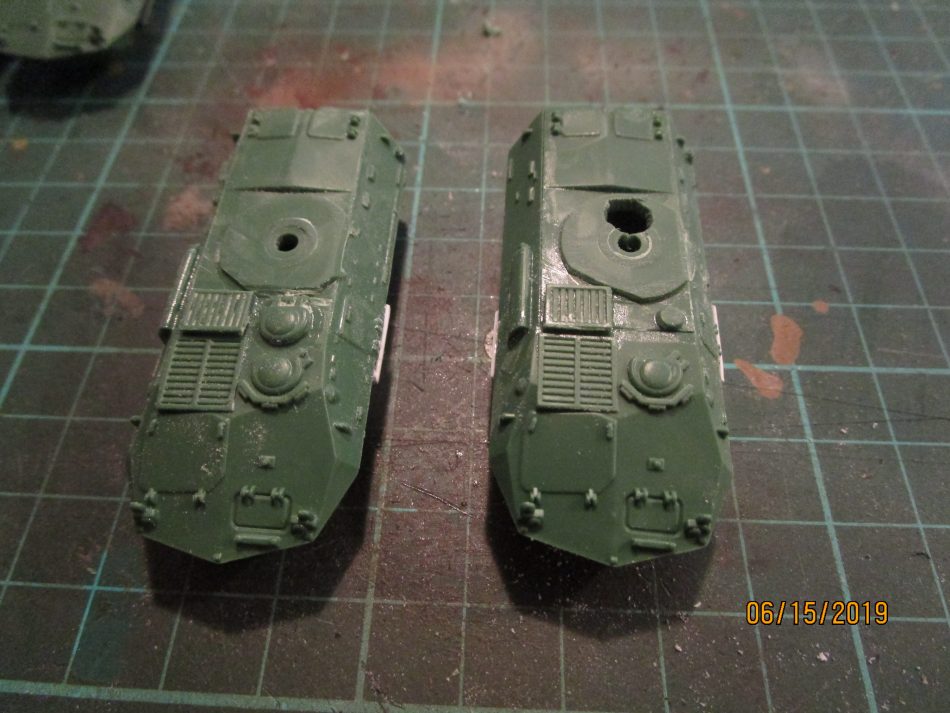
The little white plastic bit is intended to keep the barrel from depressing onto the grill. It’s a little detail that will show rivet counters that you have done your homework.
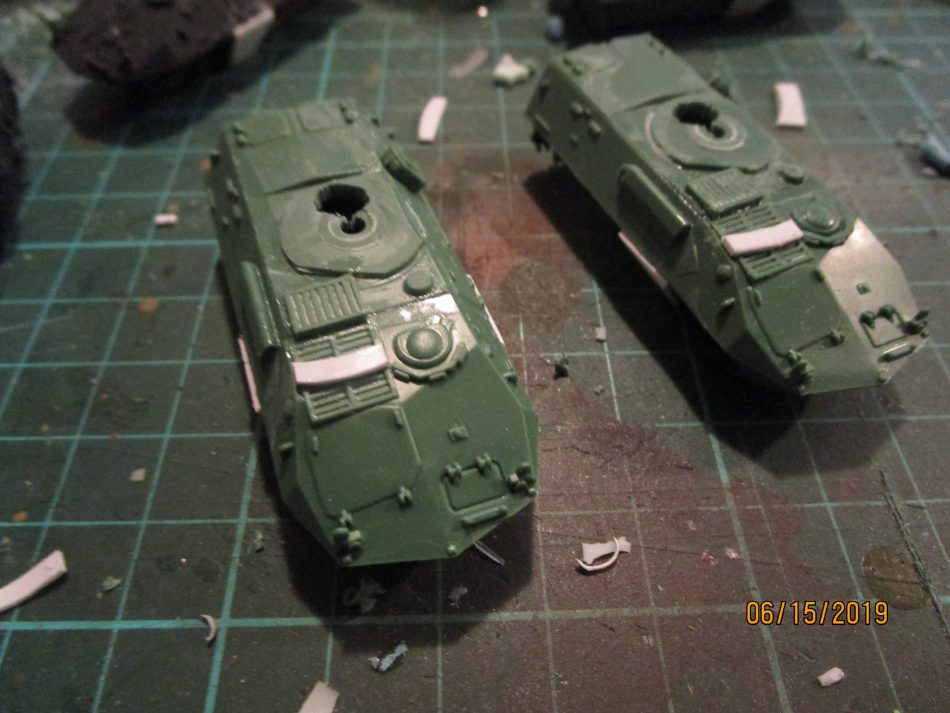
I recommend painting with the wheels off. It will allow you to get into the areas behind the wheels and you won’t have any tire areas to touch up.
Cut and mount the painted wheels as per the photo.
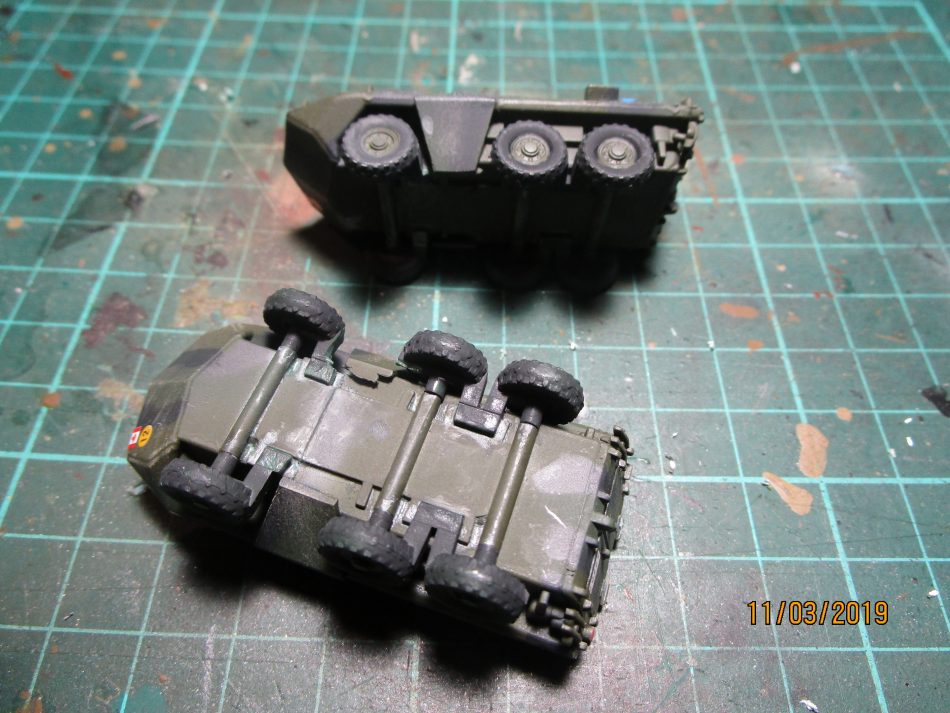 Grizzly
Grizzly
If you are doing the Brit medium recce squadron, the two HQ vehicles are Spartans and as such are armed with merely a machine gun. Therefore the infantry Grizzly version is necessary. The hull is almost the same with some exceptions. Don’t’ sand off the second vision port. Add a hatch behind the driver. You’ll have lots of spares from the Lav 25 sprues. Turret ring is a bit smaller. I used the turret from LVTP7 and trimmed it down a bit. Mine are from an old Matchbox diecast or you can use the ones on the Battlefront AAVP7 model.
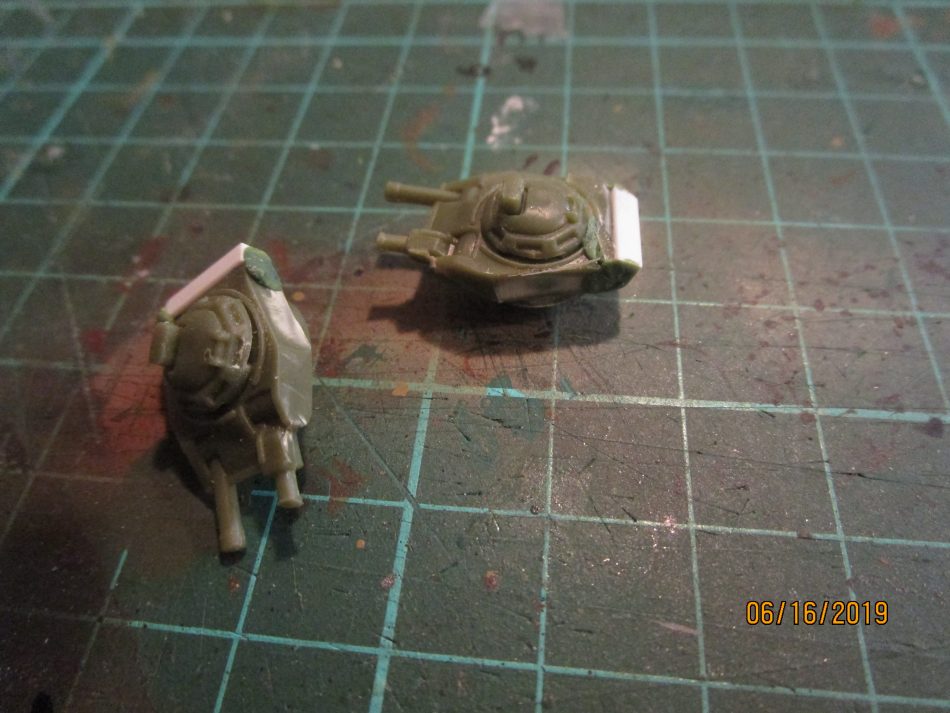 Painting
Painting
I like the original Canadian 3 colour pattern. It’s unique and no one else uses it. I used Tamiya Nato Black, XF-65 Field Gray, and a mix of XF 60 and 62 for the second green colour. Other options are solid Nato green which is what they were painted near the end of their life after re-fits. Or one can paint them white for UN duty.
I chose the Canadian three colour pattern.
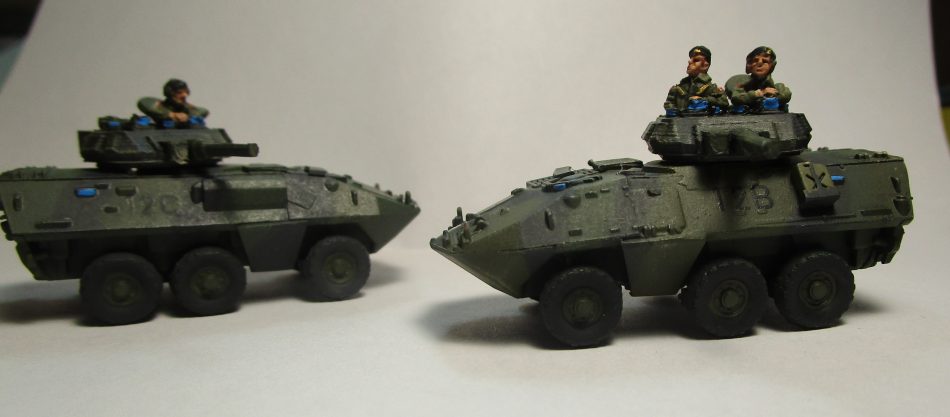
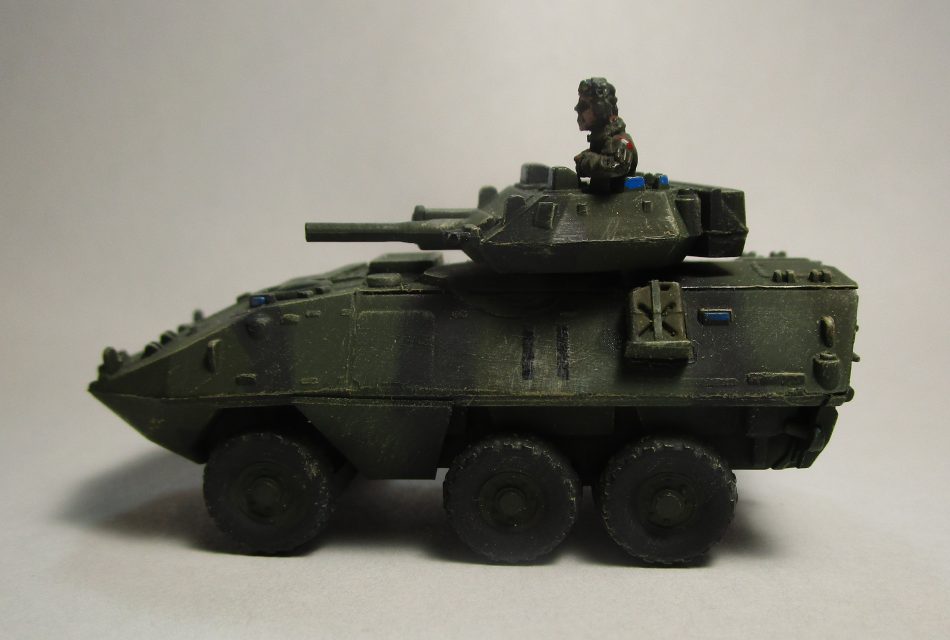
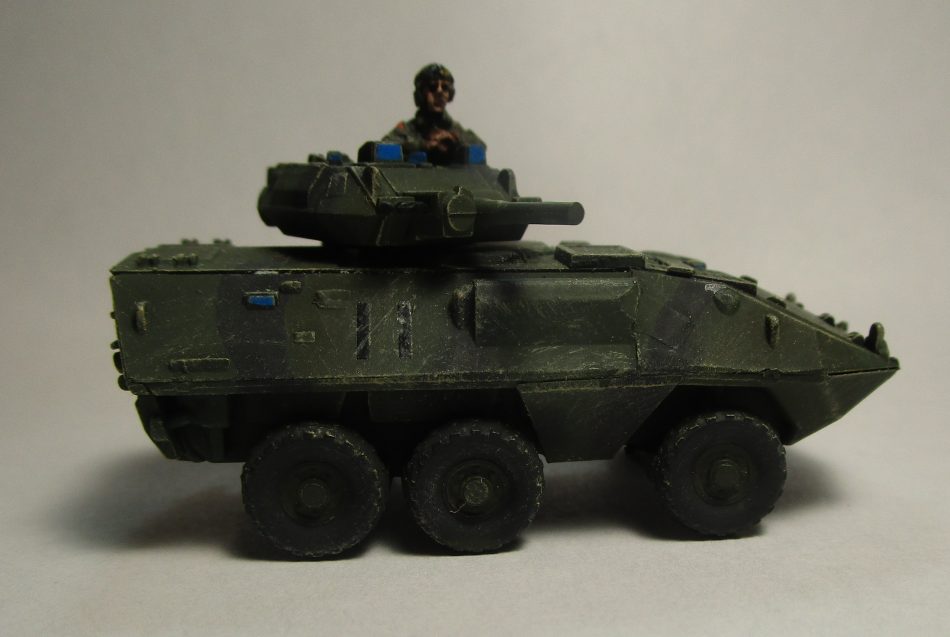

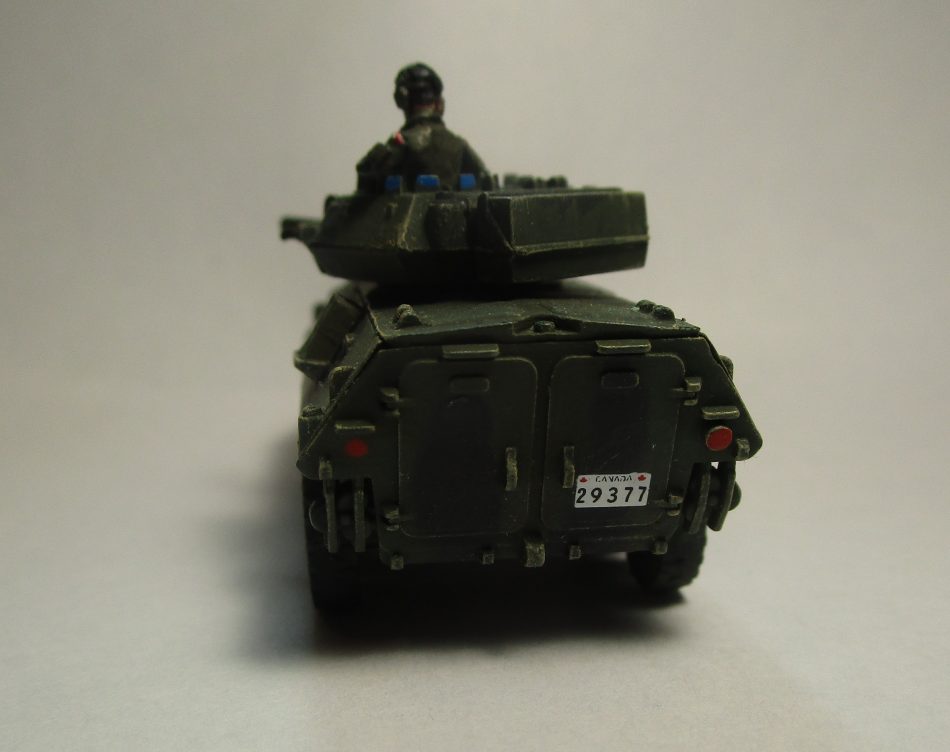 Markings
Markings
You could easily get by with no markings at all as many didn’t have much in the way of markings. You would normally see a yellow or all-black bridging symbol on the lower front of the hull on the right side. Use 12 as it was a 12-ton vehicle. Though they didn’t usually sport red and white Canadian flags, I put them on mine anyways. See photo for location. Call signs can be found on the hull sides.
I’m using A squadron in honour of my friend who commanded the first troop (call sign 11) of A Squadron, the 12ieme Regiment Blindé du Canada (12th Canadian Armoured Regiment). Affectionately known using the short form 12 RBC as 12 Rubber Boot Company. I also put a license plate on the right rear and front if you wish. I get my decals from https://tl-modellbau.de/navi.php?a=207&lang=eng TL Modellbau in Germany. I find that the letters and numbers in the Canadian set are a bit big for the Cougar so I ordered just letters and numbers in 3 mm size. They are also too big for the M113s, but they don’t seem to overpower the look of that vehicle.
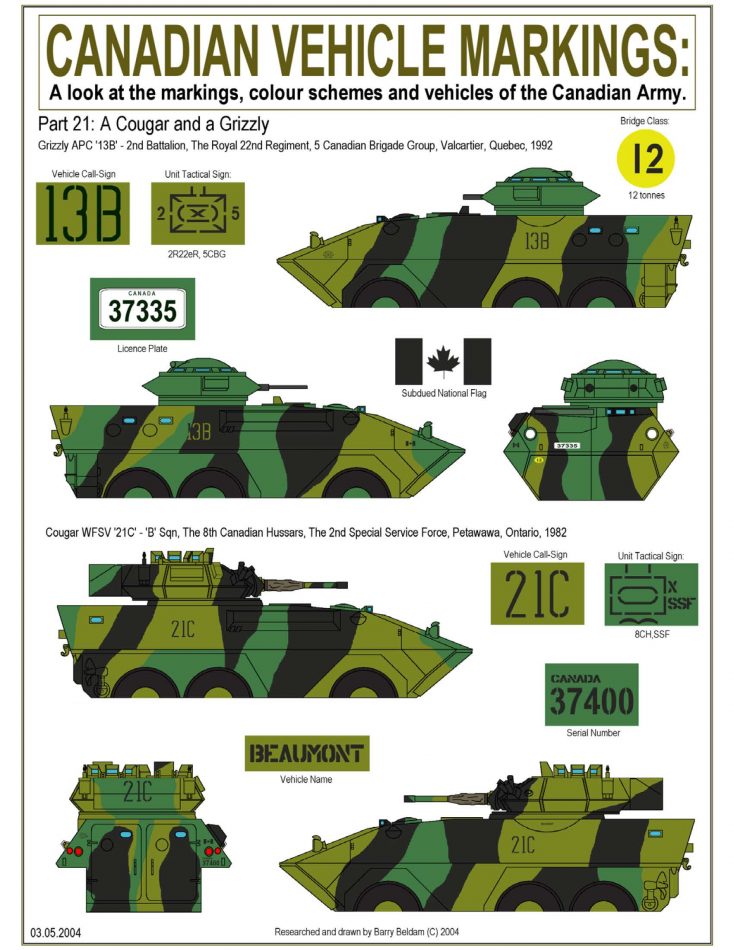 Gaming
Gaming
Use it as an allied British Scorpion Squadron. It’s great as a BMP spam buster. Though you get fewer shots than a USMC Lav 25, you get a better AT rating and more importantly a FP of +2 (rather than 5+ for the Lav or Scimitar). They also have the scout rule, so if you can get behind cover and stay gone to ground, you will be hit on nothing less than a six until you fire. I played a game where my opponent put then in cover where my reserve Leopard C1s were coming on. I thought I’d make mincemeat out of them, but I hit very few of them and then proceeded to fail my FP tests. He then came out of the cover and shot me up from the sides.
Also, make sure that your opponent doesn’t mind you using a vehicle that is not quite WYSIWYG. If they are not comfortable, just whip out those Scorpion hulls and put the turrets on them.
Further information
Anthony Sewards, a retired Canadian Army tank commander produces a series of excellent DVDs full of photos on Canadian army subjects. They can be bought from Anthony himself on Facebook or through Trackjam Models

I really appreciate the step-by-step description as well as photos. This is definitely on my to-do list!
Really great article! Love the he article. Brings good memory to mind! Adsum!
This was a great article. I was deployed with the vehicles sep 2001 – march 2002
hey Rob…great article as usual. One thing you forgot to mention is that they were amphibious. In fact they swam quite well and much better than the 113. You could almost troll off the back deck when in the water. The grizzly turret packed both a .50cal and a 7.62 GPMG. The vehicle as a whole gave much better protection to the crew and infantry loaded in the troop compartment than the 113. Unfortunately the cross country capability sucked!!! On a rainy day it would get stuck in a mud puddle!!! My call sign in 1st Battalion, The RCR was 39 back in ’88. 🙂
Luggs,
I was in a hurry to make a deadline and in hindsight I should have added some stories from some of my friends who worked on the vehicles. I think the stores would have been fun as most people outside of Canada had never heard of the vehicles. Instead I focused on the modelling aspects.
I am happy to see that you managed to save some of the Armoured Acorn files for posterity. Very nice.
Fortunately other modellers have saved his work. So they are not lost.